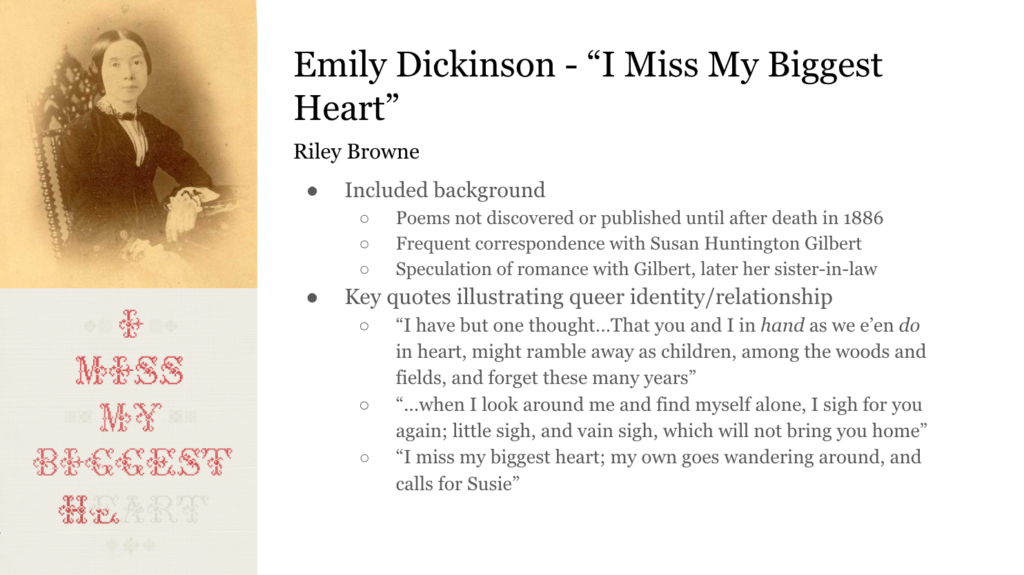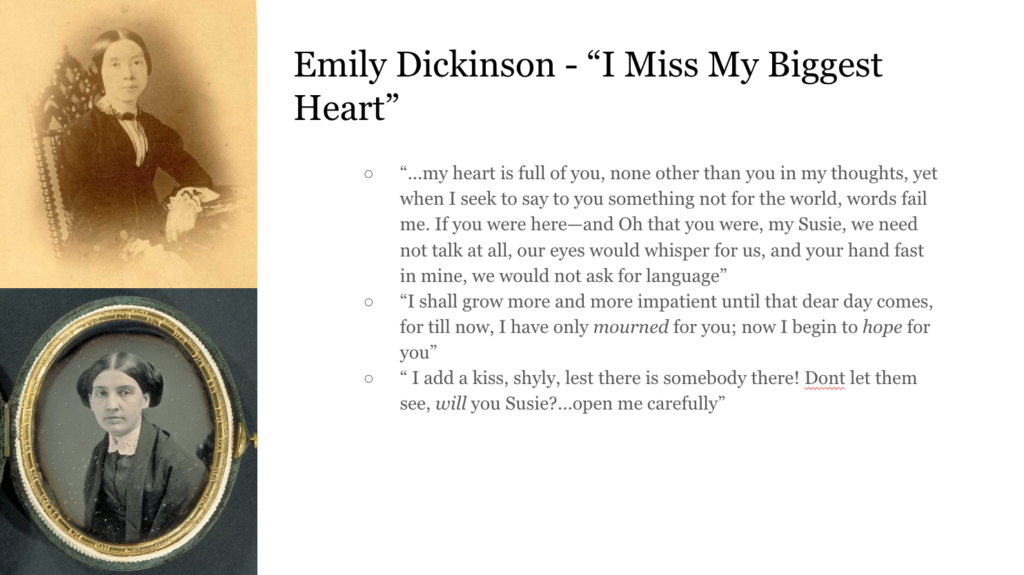October 23rd, 2023 to October 29th, 2023
This week, there was a significant focus upon historical letters of note. For my first letter, I selected a letter of Abigail Adams’, wife of John Adams and former First Lady of the United States, and for my second letter, I selected a letter of Emily Dickinson’s, the famed American poet.
For our first class this week, in which I read Abigail Adams’ letter, we went around sharing our 3-2-1 analysis and thoughts of each letter. I ended up going first due to Abigail’s letter being the first on the sign-up. Some elements I found significant to note were how Abigail and John Adams treated each other as equals, writing very differently from other couples’ letters we have previously read, the mention of disease and illness throughout the colonies, and of course, “Remembering the Ladies,” which is historically significant, hence the inclusion of the letter in this collection. The full quote reads, with no modern grammatical or spelling edits:
I long to hear that you have declared an independency — and by the way in the new Code of Laws which I suppose it will be necessary for you to make I desire you would Remember the Ladies, and be more generous and favourable to them than your ancestors. Do not put such unlimited power into the hands of the Husbands. Remember all Men would be tyrants if they could. If perticuliar care and attention is not paid to the Laidies we are determined to foment a Rebelion, and will not hold ourselves bound by any Laws in which we have no voice, or Representation.
Abigail Adams to John Adams, 31 March to 5 April 1776
Seemingly, Abigail was able to look forward about a hundred years to the peak of the Suffragette movement. Women did start rebelling in a sense, working to find their representation through themselves and their vote, not the vote of a husband. Although her wishes did not come to fruition in early United States government, and in some ways, even to later today, there have been steady strides in the feminist movement within the United States to make legislature protecting women and giving women their rights. I appreciate that John Adams was a very open minded individual, and was different than men of his era in the treatment of his wife. Frequently in the letter, Abigail speaks to him as his equal. She gave her honest thoughts and opinions, asked about what of the war she could know about from his end in a very educated manner, and gave her own educated reports of what was happening at home, especially talking about illness. Though there were still many unknowns of the time, this letter makes me wonder: what did they know about public health at the time? What were the standards? What information was still missing?
From this same class, I also learned a lot of other interesting information about other historical figures from their letters. I think the two most interesting letters shared from my perspective were “James Reynolds to Alexander Hamilton,” as in my early adolescence I was a fan of Hamilton, and “Albert Einstein to FDR,” as nuclear energy is fascinating to me, especially when examining the tragedies and meltdowns that have occurred surrounding it.
For our next class, I selected a letter from Emily Dickinson to her close friend and frequent correspondent, Susan Huntington Gilbert. I particularly chose this letter because of Emily being such a queer icon, especially in the sapphic sense. We presented in a rapid round robin format, in which we had 10 minutes to make slides and 3 minutes to present said slides. Here is what I ended up with:



I found the letter to be very beautiful in its expressive and poetic language of Emily’s love for Susan. As a queer woman, the writings were familiar of my own feelings, and reflected the modern “cottagecore” ideology that arose in 2020 during the early days of the pandemic, which became popular with queer, women-loving-woman as a form of escapism. I’ll include some of my favorite lines below.
…my heart is full of you, none other than you in my thoughts, yet when I seek to say to you something not for the world, words fail me. If you were here—and Oh that you were, my Susie, we need not talk at all, our eyes would whisper for us, and your hand fast in mine, we would not ask for language
Emily Dickinson to Susan Huntington Gilbert, 11 June 1852
I have but one thought…That you and I in hand as we e’en do in heart, might ramble away as children, among the woods and fields, and forget these many years
Emily Dickinson to Susan Huntington Gilbert, 11 June 1852
I add a kiss, shyly, lest there is somebody there! Dont let them see, will you Susie?…open me carefully
Emily Dickinson to Susan Huntington Gilbert, 11 June 1852
As I said before, this language and these sentiments are still present in lesbian culture today, and I wouldn’t be surprised if some parts derived from Dickinson herself. There are a few more interesting details to add about Dickinson: her poems remained undiscovered and unpublished until her death in 1886 and Susan later became her sister-in-law around 1856. The only poetry anyone had read of hers while she was alive were her letters, which included beautiful descriptions of nature and glimpses into her daily life. One of her first readers was likely Susan, as they corresponded through letters and, at least I’m assuming by the sounds of it, spent a lot of time together during their lives. With Susan marrying her brother, it makes me wonder: what was the situation back then? Were these two women actually romantically involved? Was Emily’s brother acting as a “beard”? Did her brother know? Or were they just two very close friends who expressed their friendship differently than many of us would today? My lesbian nature inclines me to think that they were actually in a relationship, but with both of them long gone, and one married to a man while alive, it’s hard to know the truth. I had a really great time reading and analyzing this letter, as to me, it feels like a part of queer history.
From both Abigail and Emily, I felt like reading their letters was like looking into the past at myself: I could see parts of me in their letters. Without these revolutionary women, which I believe you could argue that both of them were in spite of the nature of Emily’s publishings, would I be able to live how I do today? Did they wish to live in a more progressive period to live their lives how they wanted to? If they were women today, what would they be like? How much more would they have been able to accomplish? To read these letters, they really do make you think about the state of our world, and what women of the past have done and accomplished for women of today to live the lives we do.